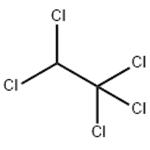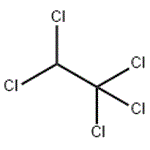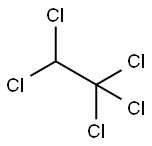- PENTACHLOROETHANE
-

- $50.00 / 1KG
-
2023-12-23
- CAS:76-01-7
- Min. Order: 1KG
- Purity: 99%
- Supply Ability: g-kg-tons, free sample is available
- PENTACHLOROETHANE
-

- $1.50 / 1g
-
2023-07-27
- CAS:76-01-7
- Min. Order: 1g
- Purity: 99.0% Min
- Supply Ability: 100 Tons
- Pentachloroethane
-

- $0.10 / 1KG
-
2020-01-14
- CAS:76-01-7
- Min. Order: 1KG
- Purity: 99.0%
- Supply Ability: 1000 tons
|
| | PENTACHLOROETHANE Basic information |
| Product Name: | PENTACHLOROETHANE | | Synonyms: | rcrawastenumberu184;PENTACHLOROETHANE, 1000MG,NEAT;PENTACHLOROETHANE PESTANAL, 250 MG;PENTACHLOROETHANE 96+%;PENTACHLOROETHANE ANALYTICAL STANDARD;Ethane,pentahloro-;1,1,2,2,2-PENTACHLOROETHANE;1,1,1,2,2-PENTA-CHLORETHANE | | CAS: | 76-01-7 | | MF: | C2HCl5 | | MW: | 202.29 | | EINECS: | 200-925-1 | | Product Categories: | refrigerants;Organics;Building Blocks;Chemical Synthesis;Halogenated Hydrocarbons;Organic Building Blocks;Alphabetic;N-PAlphabetic;Pesticides&Metabolites;Alpha Sort;P;PA - PEN;P-SAlphabetic;Volatiles/ Semivolatiles;Alkyl;Halogenated Hydrocarbons;Organic Building Blocks | | Mol File: | 76-01-7.mol |  |
| | PENTACHLOROETHANE Chemical Properties |
| Melting point | -29--22°C | | Boiling point | 161-162 °C(lit.) | | density | 1.68 g/mL at 25 °C(lit.) | | vapor pressure | 4.5 at 25 °C (Mackay and Shiu, 1981) | | refractive index | n20/D 1.502(lit.) | | Fp | 162°C | | storage temp. | 2-8°C | | solubility | Miscible with alcohol and ether (Windholz et al., 1983) | | form | Liquid | | color | Colorless | | Odor | chloroform-like odor | | Water Solubility | Insoluble in water. | | Merck | 14,7108 | | BRN | 1736845 | | Henry's Law Constant | 2.11 at 30 °C (headspace-GC, Sanz et al., 1997) | | Dielectric constant | 3.7(16℃) | | Stability: | Stable. Non-flammable. Incompatible with strong oxidizing agents. May react violently with alkalies or metals. | | CAS DataBase Reference | 76-01-7(CAS DataBase Reference) | | IARC | 3 (Vol. 41, Sup 7, 71) 1999 | | EPA Substance Registry System | Pentachloroethane (76-01-7) |
| | PENTACHLOROETHANE Usage And Synthesis |
| Chemical Properties | colourless liquid with a camphor-like smell.Pentachloroethane is incompatible and very reactive in contact with sodium potassium (alloy + bromoform), alkalis, metals, and water. On hydrolysis, pentachloroethane produces dichloroacetic acid and the reaction with alkalis and metals produces chloroacetylenes, which becomes spontaneously explosive. Pentachloroethane is a colourless stable liquid with a camphor-like smell and non-flammable. Pentachloroethane is incompatible with strong oxidising agents and reacts violently with alkalis or metals. | | Physical properties | Clear, colorless liquid with a sweetish, chloroform-like odor | | Uses | May occur as an intermediate in the
production of chlorinated ethylenes; formerly
used as a solvent for cellulose ethers, resins, and
gums, for dry cleaning, coal purification, as a
soil sterilizing agent, and as a chemical intermediate
in the production of dichloroacetic
acid | | Uses | Solvent for chemicals, resins, gums; removing oil and grease from metal parts; dry cleaning
agent; timber drying agent; fumigant. | | Uses | Pentachloroethane has been used as a solvent and chemical
intermediate but has had little commercial utilization. Pentachloroethane
is used as a solvent for oil and grease in metal
cleaning; in the separation of cola from impurities by density
difference; as a chemical intermediate in the manufacture of
tetrachloroethylene and dichloroacetic acid; as a solvent for
cellulose acetate, certain cellulose ethers, resins, and gums;
as a drying agent for timber by immersion at temperatures
greater than 100�C; in dry cleaning and soil sterilizing. | | Definition | ChEBI: Pentachloroethane is a member of the class of chloroethanes that is ethane in which five of the six hydrogens are replaced by chlorines. A non-flammable, high-boiling liquid (b.p. 161-162℃) with relative density 1.67 and an odour resembling that of chloroform, it is used as a solvent for oil and grease, in metal cleaning, and in the separation of coal from impurities. It has a role as a non-polar solvent. | | General Description | A colorless liquid with a chloroform-like odor. Insoluble in water and denser than water. Toxic by inhalation and ingestion. May irritate skin and eyes. Used as a solvent. | | Air & Water Reactions | Insoluble in water. | | Reactivity Profile | A mixture of PENTACHLOROETHANE with potassium may explode after a short delay. Reaction with alkalis or metals will produce a violent reaction. PENTACHLOROETHANE also reacts violently with NaK alloy + bromoform. PENTACHLOROETHANE is incompatible with strong oxidizing agents. | | Health Hazard | Irritation of skin, lungs, eyes, and mucous membrane; depression of central nervous system; and toxicity similar to tetrachloroethanes. | | Safety Profile | Poison by inhalation and intravenous routes. Moderately toxic by ingestion and subcutaneous routes. An irritant. Questionable carcinogen with experimental carcinogenic data. Flammable when exposed to heat or flame. Moderately explosive by spontaneous chemical reaction. To fight fire, use water, CO2, dry chemical. Dehalogenation by reaction with alkalies, metals, etc., wdl produce spontaneously explosive chloroacetylenes. Violent reaction with NaK alloy + bromoform. Mixtures with potassium are very shock-sensitive explosives. When heated to decomposition it emits highly toxic fumes of Cl-. See also CHLORINATED HYDROCARBONS, ALIPHATIC. | | Carcinogenicity | The NTP performed a carcinogenesis/
general toxicity bioassay with F344/N rats
and B6C3F1 mice. Chronic inflammation of the kidney
and interstitial inflammation of lung were observed in
male rats with a positive dose–response relationship. A
Frank effect level of 54 for male rats was observed. NTP
concluded that “Under the conditions of this bioassay, technical
grade pentachlorethane containing 4.2% hexachlorethane
(known carcinogen in mice) was not carcinogenic
in F344/N rats. The decreased survival of dosed rats was
confounding. Pentachloroethane was nephrotoxic to male
rats. Technical grade pentachloroethane was carcinogenic for
B6CeF1 mice, causing hepatocellular carcinomas in males
and females and adenomas in females. This study was cited by IARC as a limited evidence for the carcinogenicity
of pentachloroethane in experimental animals. Combined
with the lack of epidemiological data for exposure, IARC
stated that pentachloroethane was not classifiable as carcinogenic
to humans. There is concern for the possibility of
a-2 m-globulin nephropathy occurring. However, considering
that the pathological sequence of lesions has not
been fully established, this cannot be verified. When fed
5 days/week to male rats for 104 weeks at doses of 75 and
150 mg/kg/day, mortality was excessive and body weight
gain was below controls starting at 76 weeks. Weight gain
was decreased in female rats at both levels starting at
42 weeks, but mortality in both sexes was increased only
at 150 mg/kg/day.No increase in tumors was found, but there
was a dose-related increase in the incidence of chronic
renal inflammation of male rats and mineralization of
renal papillae.
Survival of mice similarly treated with 250–500 mg/kg/
day was significantly shortened, and hepatocellular carcinomas
were increased. The only other tumor showing an
increase was in female mice, where there was a dose-related
increase in hepatocellular adenoma. The cause of death did
not appear to be either the renal lesions in male rats or the
liver tumors in mice, and no other target organs were found to
explain the deaths. | | Environmental fate | Chemical/Physical. At various pHs, pentachloroethane hydrolyzed to tetrachloroethylene
(Jeffers et al., 1989; Roberts and Gschwend, 1991). Dichloroacetic acid was also reported as a
hydrolysis product. Reacts with alkalies and metals producing explosive chloroacetylenes
(NIOSH, 1997). The reported hydrolysis half-life at 25 °C and pH 7 is 3.6 d (Jeffers et al., 1989).
In anoxic hypolimnion samples collected from Lower Mystic Lake, MA, pentachloroethane was
abiotically transformed within days to tetrachloroethylene via dehydrohalogenation pathway and
to trichloroethylene via reductive elimination. After 10 d, mass balances of 91 and 86% were
reported for unaltered and filter-sterilized samples, respectively. A disappearance rate constant of
0.26/d was reported for pentachloroethane for both the unaltered and filter-sterilized samples. The
disappearance of pentachloroethane was abiotic in origin due to the reactions with naturally
occurring aqueous polysulfides, H2S and Sn-2 (Miller et al., 1998a).
The evaporation half-life of pentachloroethane (1 mg/L) from water at 25 °C using a shallowpitch
propeller stirrer at 200 rpm at an average depth of 6.5 cm was 46.5 min (Dilling, 1977). | | Purification Methods | Usual impurities include trichloroethylene. It partially decomposes if it is distilled at atmospheric pressure. Drying it with CaO, KOH or sodium is unsatisfactory because of the elimination of the elements of HCl. It can be purified by steam distillation, or by washing with conc H2SO4, water, and then aqueous K2CO3, drying with solid K2CO3 or CaSO4, and fractionally distilling under reduced pressure. [Beilstein 2 IV 147.] |
| | PENTACHLOROETHANE Preparation Products And Raw materials |
|